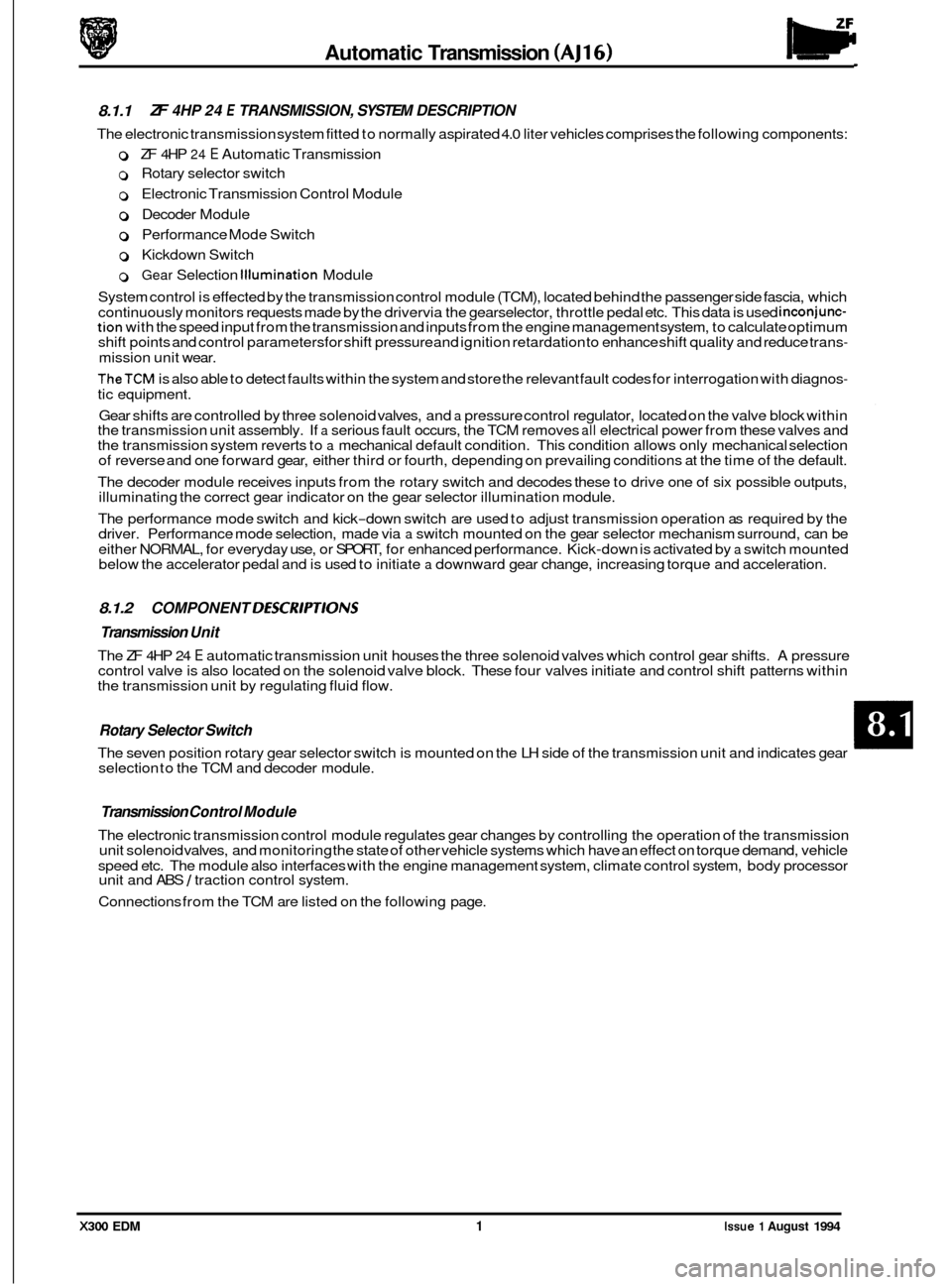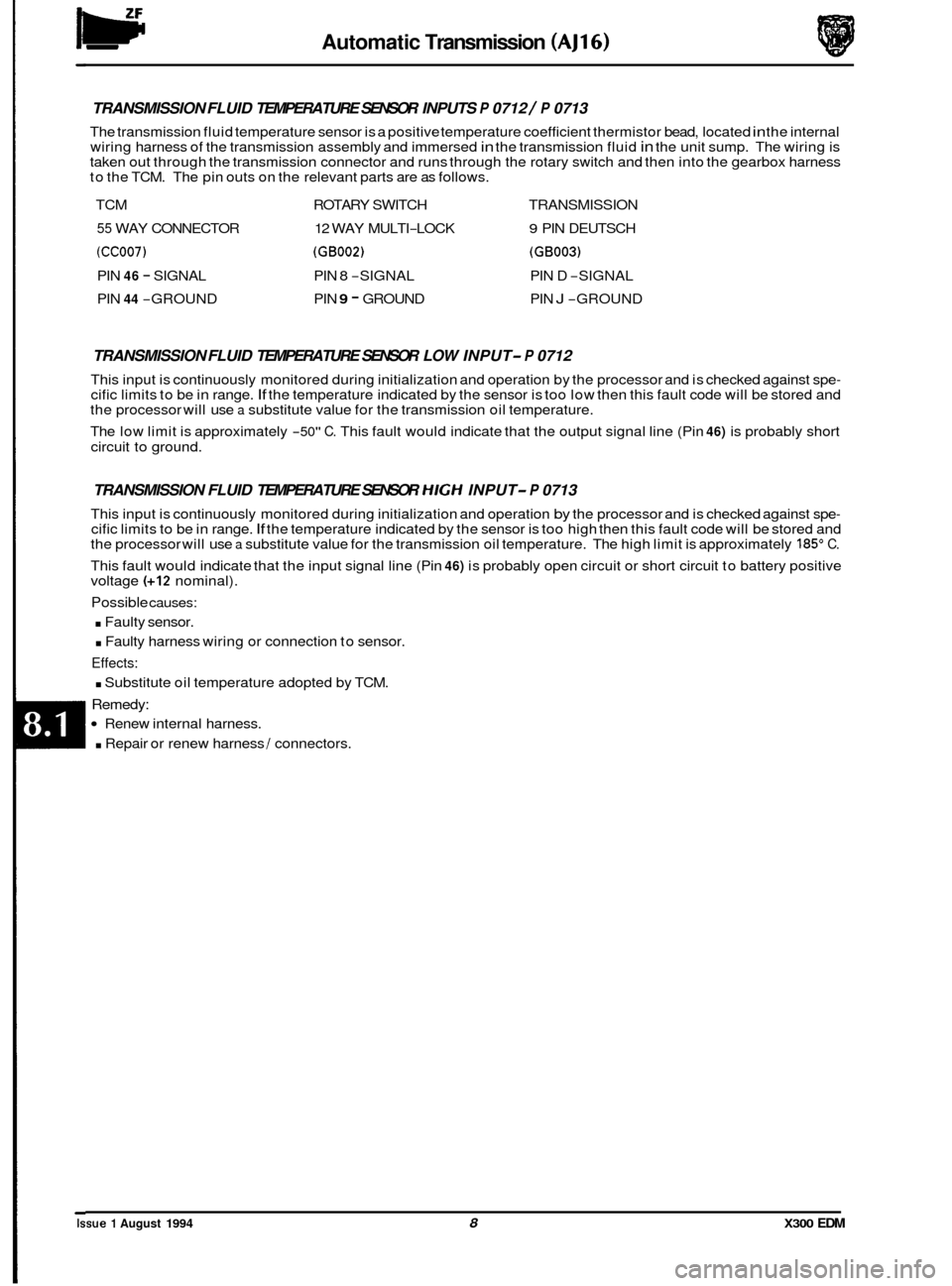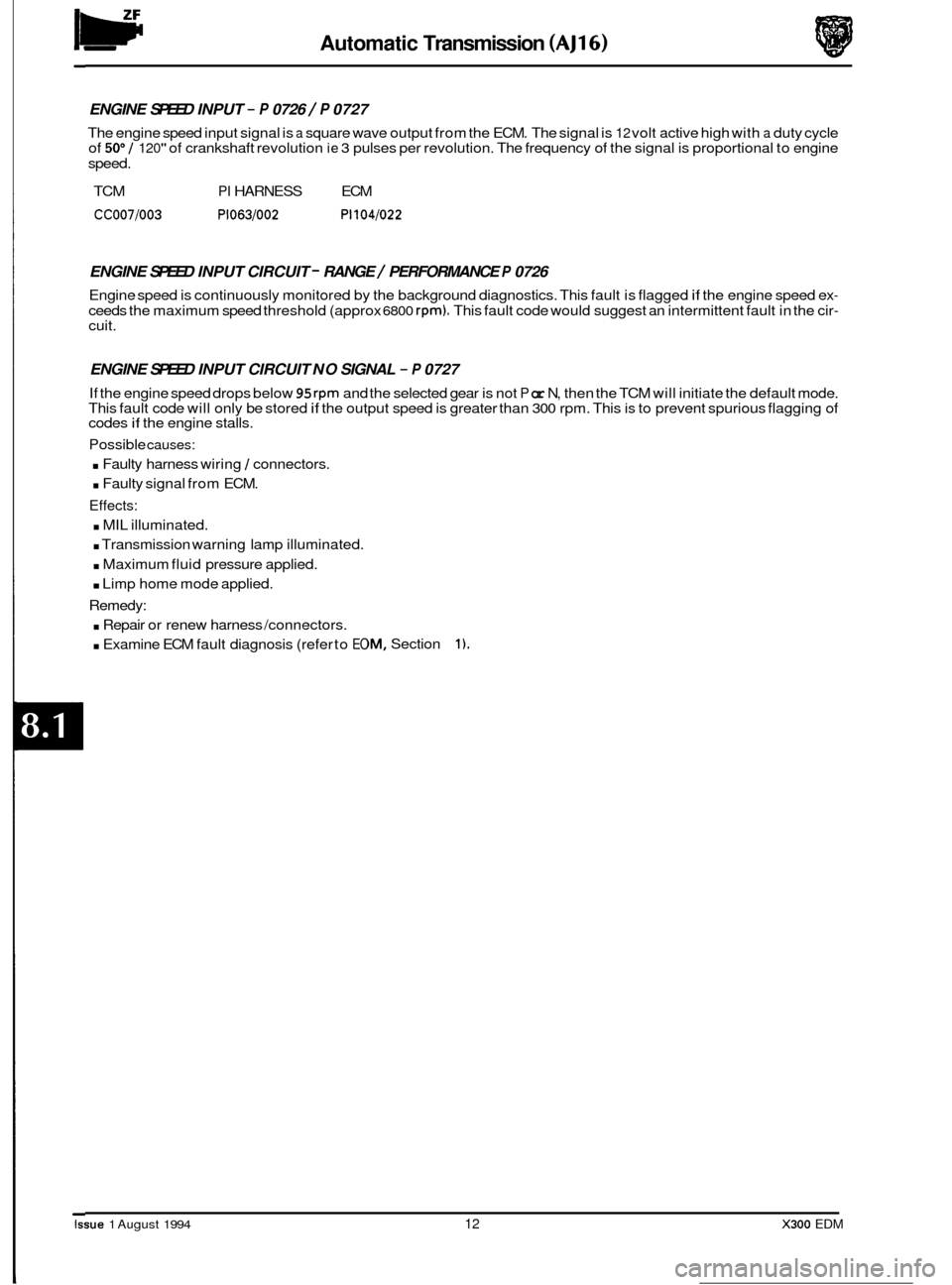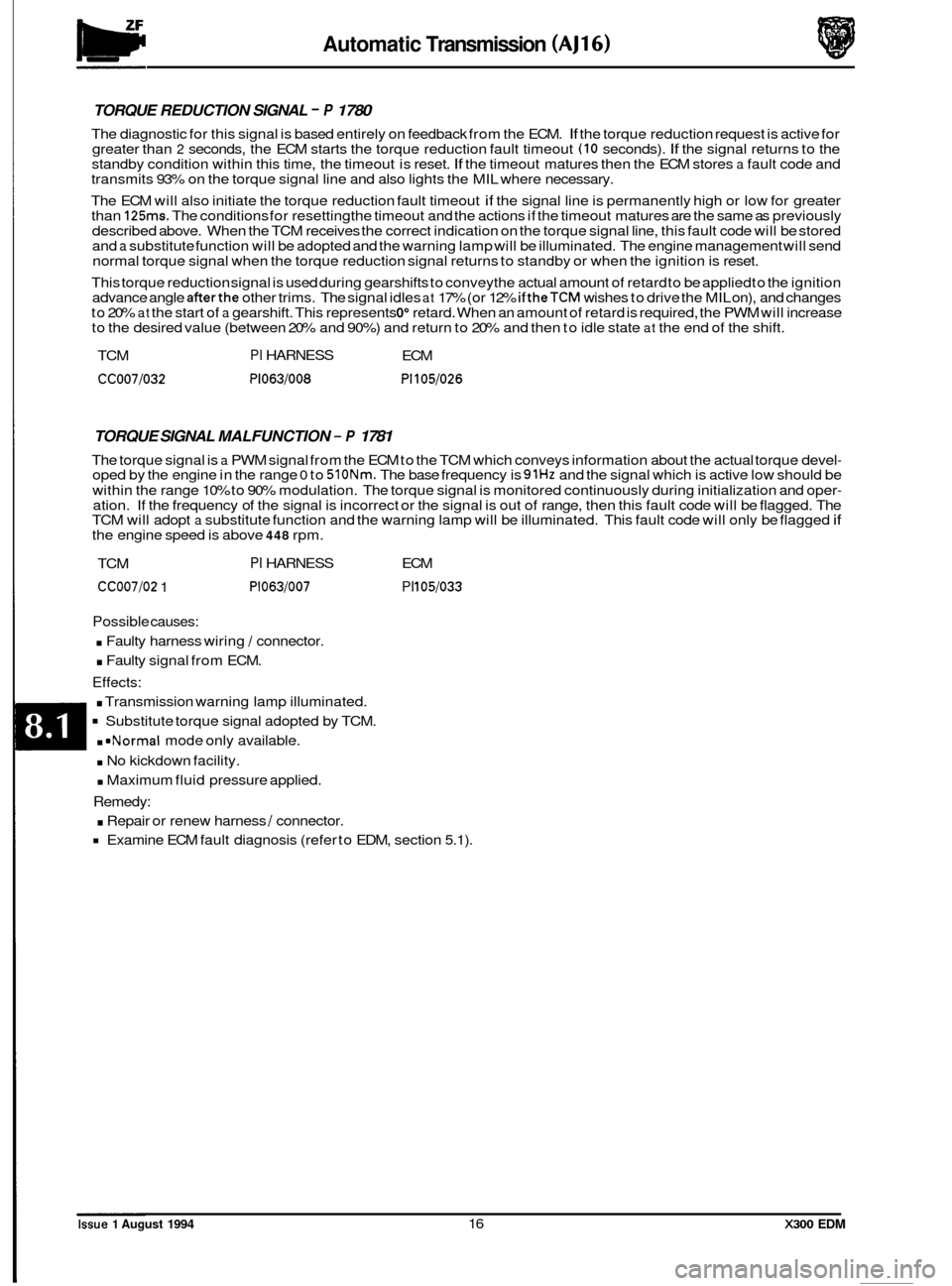1994 JAGUAR XJ6 automatic transmission fluid
[x] Cancel search: automatic transmission fluidPage 4 of 327

Automatic Transmission (AJ16) w
8.1.1 ZF 4HP 24 E TRANSMISSION, SYSTEM DESCRIPTION
The electronic transmission system fitted to normally aspirated 4.0 liter vehicles comprises the following components:
0 ZF 4HP 24 E Automatic Transmission
0 Rotary selector switch
0 Electronic Transmission Control Module
0 Decoder Module
0 Performance Mode Switch
0 Kickdown Switch
0 Gear Selection Illumination Module
System control is effected by the transmission control module (TCM), located behind the passenger side fascia, which
continuously monitors requests made by the drivervia the gearselector, throttle pedal etc. This data is used
inconiunc- tion with the speed input from the transmission and inputs from the engine management system, to calculate optimum
shift points and control parametersfor shift pressure and ignition retardation to enhance shift quality and reduce trans-
mission unit wear.
TheTCM is also able to detect faults within the system and store the relevant fault codes for interrogation with diagnos-
tic equipment.
Gear shifts are controlled by three solenoid valves, and
a pressure control regulator, located on the valve block within
the transmission unit assembly. If a serious fault occurs, the TCM removes all electrical power from these valves and
the transmission system reverts to a mechanical default condition. This condition allows only mechanical selection
of reverse and one forward gear, either third or fourth, depending on prevailing conditions at the time of the default.
The decoder module receives inputs from the rotary switch and decodes these to drive one of six possible outputs,
illuminating the correct gear indicator on the gear selector illumination module.
The performance mode switch and kick
-down switch are used to adjust transmission operation as required by the
driver. Performance mode selection, made via a switch mounted on the gear selector mechanism surround, can be
either NORMAL, for everyday use, or SPORT, for enhanced performance. Kick
-down is activated by a switch mounted
below the accelerator pedal and is used to initiate a downward gear change, increasing torque and acceleration.
8.1.2 COMPONENT DESCRlPTIONS
Transmission Unit
The ZF 4HP 24 E automatic transmission unit houses the three solenoid valves which control gear shifts. A pressure
control valve is also located on the solenoid valve block. These four valves initiate and control shift patterns within
the transmission unit by regulating fluid flow.
Rotary Selector Switch
The seven position rotary gear selector switch is mounted on the LH side of the transmission unit and indicates gear
selection to the TCM and decoder module.
Transmission Control Module
The electronic transmission control module regulates gear changes by controlling the operation of the transmission
unit solenoid valves, and monitoring the state of other vehicle systems which have an effect on torque demand, vehicle
speed etc. The module also interfaces with the engine management system, climate control system, body processor
unit and ABS
I traction control system.
Connections from the TCM are listed on the following page.
X300 EDM 1 Issue 1 August 1994
Page 7 of 327

Automatic Transmission (AJ16)
8.1.3 DIAGNOSTIC FAULT CODES
The following codes are stored within the TCM whenever a fault is detected on the system. The codes can be accessed
using Jaguar Diagnostic Equipment or a hand held, proprietary scan tool.
Code Description
MIL Indication Page No.
P 0603 Internal control module memory error MIL on 26
P 0605 Internal control module ROM test error
MIL on 26 I P 0702 Transmission control system electrical MIL on 5
P 0705 Transmission range sensor circuit malfunction MIL on 6
P 0706 Transmission range sensor circuit range / performance MIL on 6
8
8
P 0712 Transmission fluid temperature sensor low input -
P 0713 Transmission fluid temperature sensor high input -
P 0721 Output speed sensor circuit range / performance MIL on 10
P 0722 Output speed sensor circuit no signal MIL on 10
P 0726 MIL on 12
P 0727 1 Engine speed input circuit no signal MIL on 12
P 0743 Torque converter clutch system electrical MIL on 14
P 0748 Pressure control solenoid electrical MIL on 14
' Engine speed input circuit range / performance
P 0753 Shift solenoid A electrical MIL on 14
P 0758 Shift solenoid B electrical MIL on 14
P 1608 TCM watch-dog fault MIL on 26
P 1780 Torque reduction signal malfunction - 16
P 1781 Torque signal malfunction - 16
P 1782 Traction control input electrical - 18
P 1785 Transmission fault lamp malfunction - 20
P 1790 TP signal system range / performance MIL on 21
P 1791 TP electrical signal system MIL
on 21
P 1792 Sport mode indicator - 23
P 1794 System voltage malfunction MIL on 24
P 1796 Kickdown switch system - 24
t: Codes which do not cause the MIL to illuminate cannot be read by the hand-held scan tool as they are not SA€ P- generated.
I. Transmission Control Module (TCM)
2. Transmission Unit
3. TCM Multi-pin Connector
4. Transmission Rotary Switch
5. Transmission Connector Plug
6. Engine Control Module
7. Instrument Pack
8. ABS /Traction Control Control Module
9. Kickdown Switch
Issue 1 August 1994 4 X300 EDM
Page 8 of 327

Automatic Transmission (AJ16)
8.1.4 FA U1 T DIAGNOSIS
Transmission Control System Electrical - P 0702 (Fig. 1)
This fault code is associated with the internal relay of the Transmission Control Module, (TCM). This relay provides a
means of isolating the electro-mechanical, controlling, solenoids from the supply, allowing the transmission to revert
to a mechanical default condition.
The relay and associated circuitry is tested once during initialization and whenever
a hardware reset occurs. When the
ignition is first switched on the TCM carries out an initialization routine. During this routine the processor drives the
relay
ON then tests for the supply voltage on the output via a feedback path. If the supply voltage is not seen within
a specific time then
a fault is flagged and the TCM will run in default mode and this fault code will be stored.
A set time after the relay is turned on, it is turned off and the processor then tests for the supply again. If it is still present,
then the TCM will run in default mode and this fault code will be stored.
U: The ignition supply voltage must be greater than 8V for a fault code to be stored. If this fault is permanently
flagged, the TCM should be replaced taking care to obtain the correctly programmed variant.
Possible causes:
Faulty TCM internal relay.
Effects:
. MIL illuminated.
. Transmission warning lamp illuminated.
. Maximum fluid pressure applied.
Limp home mode applied.
. RenewTCM.
Remedy:
Fig. 1
X300 EDM 5 Issue 1 August 1994
Page 9 of 327

w Automatic Transmission (AJ16)
TRANSMISSION RANGE SENSOR - P 0705 / P 0706
The rotary switch is located on the LH side of the transmission. The harness incorporates the transmission wiring and
runs into the car through the a hole in the LH side of the tunnel. The connectors GBOOI and GB002 are located on the
side of the selector mechanism ‘J’ gate assembly.
TRANSMISSION RANGE SENSOR CIRCUIT - P 0705
This test is performed continuously by the background diagnostics during operation. The test is a plausibility check
on the 3 bit Gray code. The test criteria is that an invalid code must not be seen. If a Z code is seen for more than looms,
then this fault code will be stored and the transmission will adopt the default function.
TRANSMISSION RANGE SENSOR CIRCUIT RANGE/ PERFORMANCE - P 0706
This is a plausibilitycheck on the 3 bit Gray code which is only performed once during cranking when the engine speed
reaches
a specific threshold. If the gear is not P or N when this test is performed, then this fault code will be flagged
and the transmission will adopt the default function.
ROTARY SWITCH
(GB002)
PIN 1 -SWITCH COMMON
PIN
2 -CODE X OUTPUT
PIN
3 -CODE Y OUTPUT
PIN
4 -CODE Z OUTPUT
Possible causes
Open circuit on X, Y or Z line from rotary switch.
9 Faulty operation of rotary switch.
Effects:
. MIL illuminated.
. Transmission warning lamp illuminated.
. Maximum fluid pressure applied.
. Limp home mode applied.
Remedy:
. Repair or renew harness I connectors.
. Check selector cable and adjust or renew if necessary.
. Check rotary switch and adjust or renew if necessary.
X300 EDM Issue 1 August 1994 6
Page 11 of 327

IW Automatic Transmission (AJ16)
TRANSMISSION FLUID TEMPERATURE SENSOR INPUTS P 0712 / P 0713
The transmission fluid temperature sensor is a positive temperature coefficient thermistor bead, located in the internal
wiring harness of the transmission assembly and immersed in the transmission fluid in the unit sump. The wiring is
taken out through the transmission connector and runs through the rotary switch and then into the gearbox harness
to the TCM. The pin outs on the relevant parts are as follows.
TCM ROTARY SWITCH TRANSMISSION
55 WAY CONNECTOR 12 WAY MULTI-LOCK 9 PIN DEUTSCH
(CC007) (GB002) (GB003)
PIN 46 - SIGNAL PIN 8 -SIGNAL PIN D -SIGNAL
PIN
44 -GROUND PIN 9 - GROUND PIN J -GROUND
TRANSMISSION FLUID TEMPERATURE SENSOR LOW INPUT- P 0712
This input is continuously monitored during initialization and operation by the processor and is checked against spe- cific limits to be in range. If the temperature indicated by the sensor is too low then this fault code will be stored and
the processor will use a substitute value for the transmission oil temperature.
The low limit is approximately
-50" C. This fault would indicate that the output signal line (Pin 46) is probably short
circuit to ground.
TRANSMISSION FLUID TEMPERATURE SENSOR HIGH INPUT- P 0713
This input is continuously monitored during initialization and operation by the processor and is checked against spe- cific limits to be in range. If the temperature indicated by the sensor is too high then this fault code will be stored and
the processor will use a substitute value for the transmission oil temperature. The high limit is approximately 185" C.
This fault would indicate that the input signal line (Pin 46) is probably open circuit or short circuit to battery positive
voltage (+I2 nominal).
Possible causes:
. Faulty sensor.
. Faulty harness wiring or connection to sensor.
Effects:
. Substitute oil temperature adopted by TCM.
Remedy:
Renew internal harness.
. Repair or renew harness I connectors.
Issue 1 August 1994 8 X300 EDM
Page 15 of 327

w Automatic Transmission (AJ16)
ENGINE SPEED INPUT - P 0726 / P 0727
The engine speed input signal is a square wave output from the ECM. The signal is 12 volt active high with a duty cycle
of 50" / 120" of crankshaft revolution ie 3 pulses per revolution. The frequency of the signal is proportional to engine
speed.
TCM
PI HARNESS ECM
CC007/003 P1063/002 Pl104/022
ENGINE SPEED INPUT CIRCUIT - RANGE / PERFORMANCE P 0726
Engine speed is continuously monitored by the background diagnostics. This fault is flagged if the engine speed ex-
ceeds the maximum speed threshold (approx 6800 rpm). This fault code would suggest an intermittent fault in the cir- cuit.
ENGINE SPEED INPUT CIRCUIT NO SIGNAL - P 0727
If the engine speed drops below 95 rpm and the selected gear is not P or N, then the TCM will initiate the default mode.
This fault code will only be stored if the output speed is greater than 300 rpm. This is to prevent spurious flagging of
codes if the engine stalls.
Possible causes:
. Faulty harness wiring 1 connectors.
. Faulty signal from ECM.
Effects:
. MIL illuminated.
. Transmission warning lamp illuminated.
. Maximum fluid pressure applied.
. Limp home mode applied.
Remedy:
. Repair or renew harness /connectors.
. Examine ECM fault diagnosis (refer to EC Section 1).
Issue 1 August 1994 12 X300 EDM
Page 17 of 327

w Automatic Transmission (AJ16)
SOL ENOlD VALVES
The following tests are performed continuously by a background task. If a fault is detected, it is filtered for a set period.
When filtering ends a fault code is stored in the TCM and action is taken to ensure the integrity of the system.
During limp home mode the internal relay is turned
off to remove the supply to the solenoids and the gearbox with default to fourth gear (if aforward gear is alreadyselected) and third gear (if P.R.N.). Selecting N and then D will engage
3rd gear only.
Each test checks that the feedback from the output stage module is consistent
with the driven state of the solenoid
output, detects short circuit to ground, short circuit to battery voltage and open circuit.
TORQUE CONVERTER CLUTCH SYSTEM - P 0743
PRESSURE CONTROL SOLENOID ELECTRICAL
- P 0748
SHIFTSOLENOID A ELECTRICAL - P 0753
SHIH SOLENOID B ELECTRICAL - P 0758
TCM TRANSMISSION
ccoo7/042 G B003/L
CC007l005 GBOOYH
ccoo7/024 GB003lK
CC007/006 GB003/B
CC007/0 19 G B003/M
TORQUE CONVERTER CLUTCH
SHIFT SOLENOID
A
SHIFT SOLENOID B
PRESSURE CONTROL SOLENOID
SOLENOID SUPPLY
Possible Causes:
. Faulty valve.
Faulty harness wiring /connectors.
Effects:
MIL illuminated.
. Transmission warning lamp illuminated.
Maximum fluid pressure applied.
Limp home mode applied.
Remedy:
Renew valve.
. Repair or renew harness I connector.
Issue 1 August 1994 14 X300 EDM
Page 19 of 327

Automatic Transmission (AJ16)
TORQUE REDUCTION SIGNAL - P 1780
The diagnostic for this signal is based entirely on feedback from the ECM. If the torque reduction request is active for
greater than 2 seconds, the ECM starts the torque reduction fault timeout (IO seconds). If the signal returns to the
standby condition within this time, the timeout is reset. If the timeout matures then the ECM stores a fault code and
transmits 93% on the torque signal line and also lights the MIL where necessary.
The ECM will also initiate the torque reduction fault timeout
if the signal line is permanently high or low for greater
than 125ms. The conditions for resetting the timeout and the actions if the timeout matures are the same as previously
described above. When the TCM receives the correct indication on the torque signal line, this fault code will be stored
and
a substitute function will be adopted and the warning lamp will be illuminated. The engine management will send
normal torque signal when the torque reduction signal returns to standby or when the ignition is reset.
This torque reduction signal is used during gearshifts to conveythe actual amount of retard to be applied to the ignition
advance angle
afterthe other trims. The signal idles at 17% (or 12% if theTCM wishes to drive the MIL on), and changes
to 20% at the start of a gearshift. This represents 0" retard. When an amount of retard is required, the PWM will increase
to the desired value (between 20% and 90%) and return to 20% and then to idle state at the end of the shift.
TCM
PI HARNESS ECM
CC007/032 P1063/008 P1105/026
TORQUE SIGNAL MALFUNCTION - P 1781
The torque signal is a PWM signal from the ECM to the TCM which conveys information about the actual torque devel- oped by the engine in the range 0 to 510Nm. The base frequency is 91Hz and the signal which is active low should be
within the range 10% to 90% modulation. The torque signal is monitored continuously during initialization and oper
- ation. If the frequency of the signal is incorrect or the signal is out of range, then this fault code will be flagged. The
TCM will adopt a substitute function and the warning lamp will be illuminated. This fault code will only be flagged if the engine speed is above 448 rpm.
TCM
PI HARNESS ECM
CC007/02 1 P1063/007 PI 105/033
Possible causes:
. Faulty harness wiring I connector.
. Faulty signal from ECM.
Effects:
. Transmission warning lamp illuminated.
Substitute torque signal adopted by TCM.
. =Normal mode only available.
. No kickdown facility.
. Maximum fluid pressure applied.
Remedy:
. Repair or renew harness / connector.
Examine ECM fault diagnosis (refer to EDM, section 5.1).
Issue 1 August 1994 16 X300 EDM